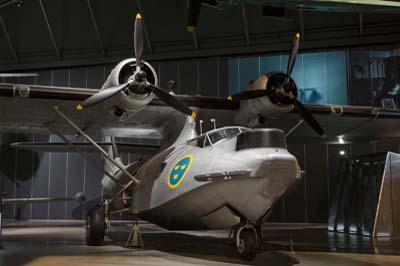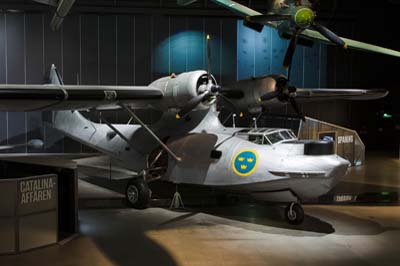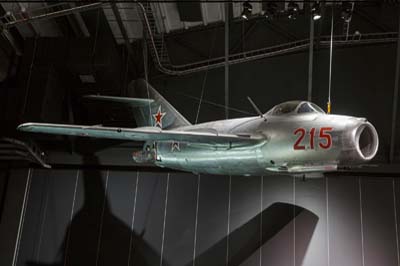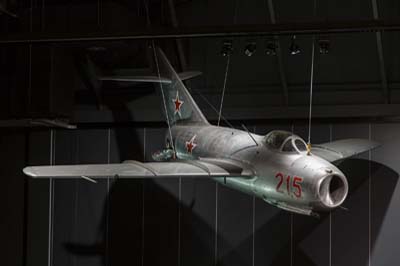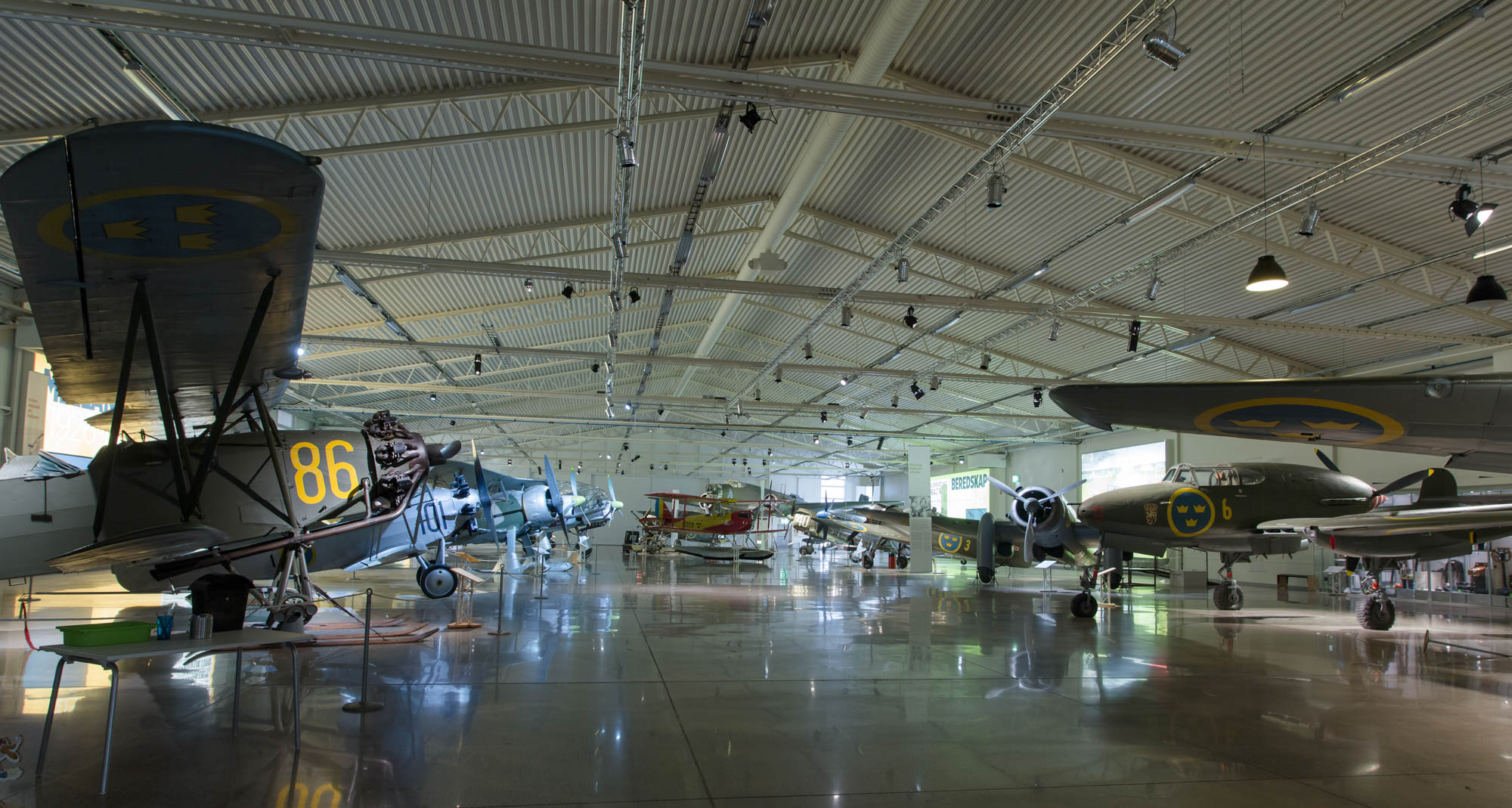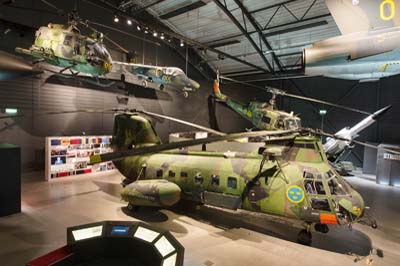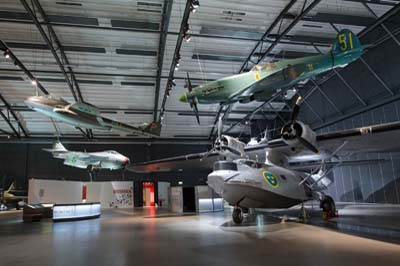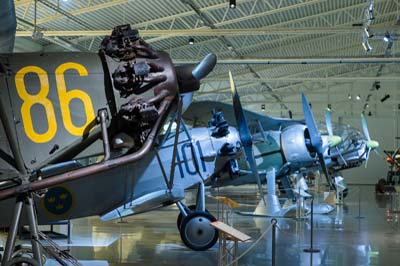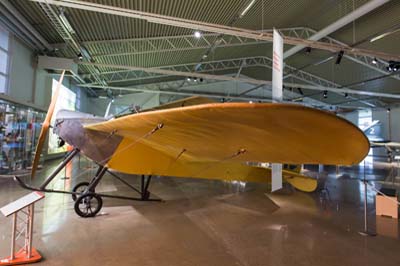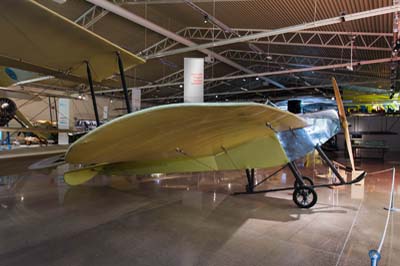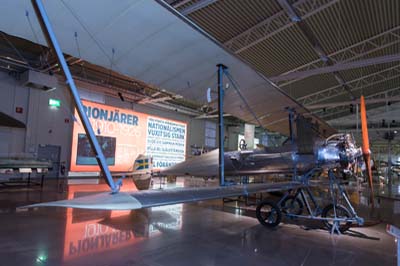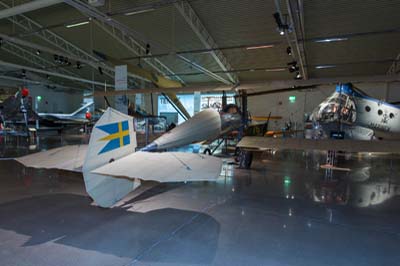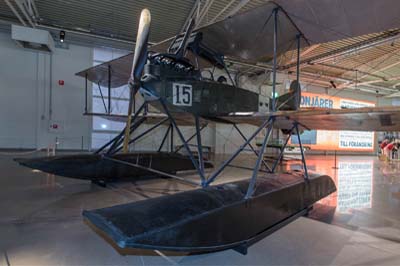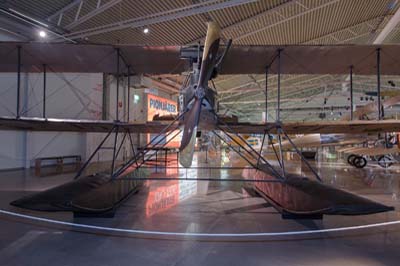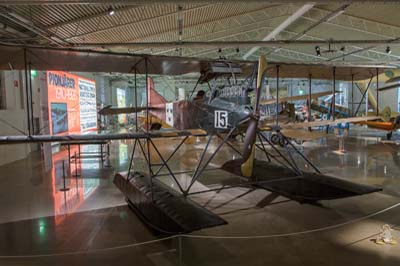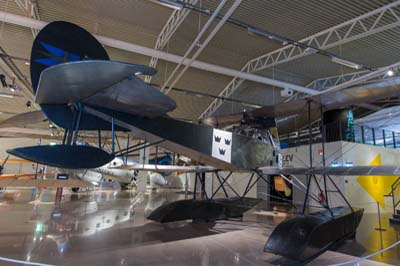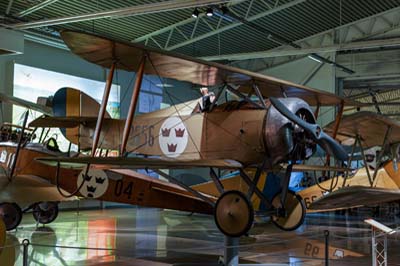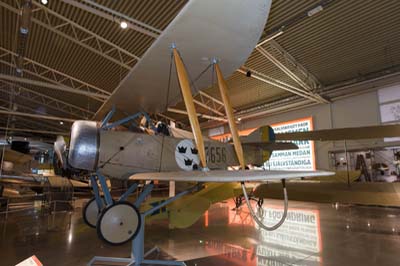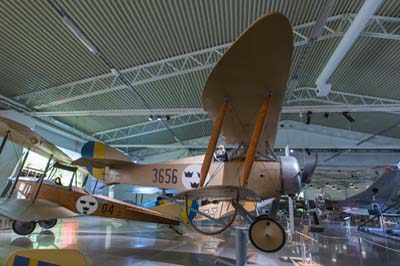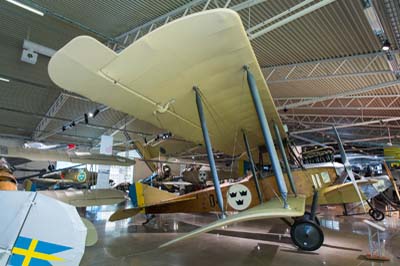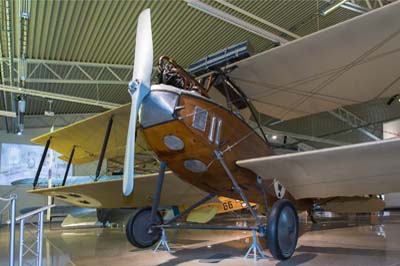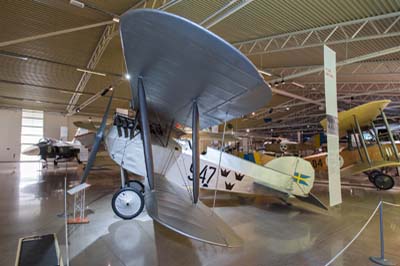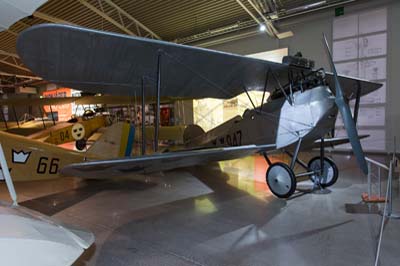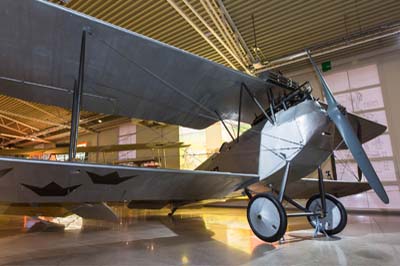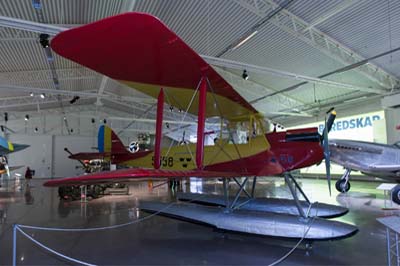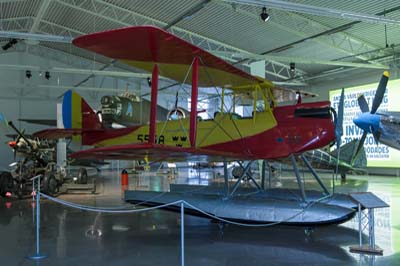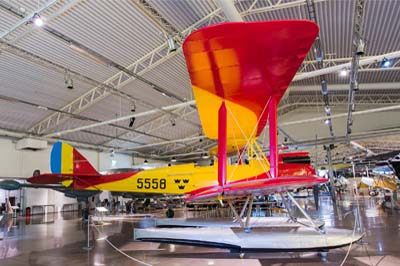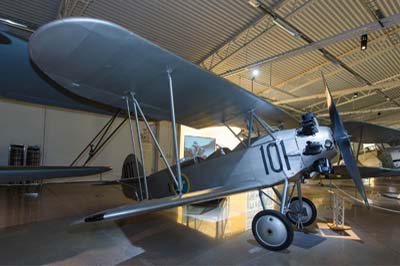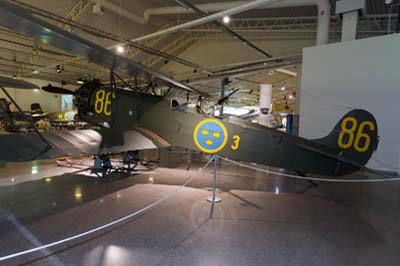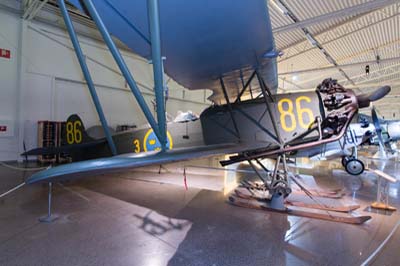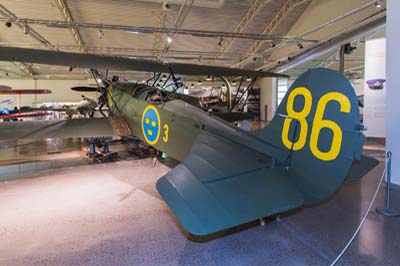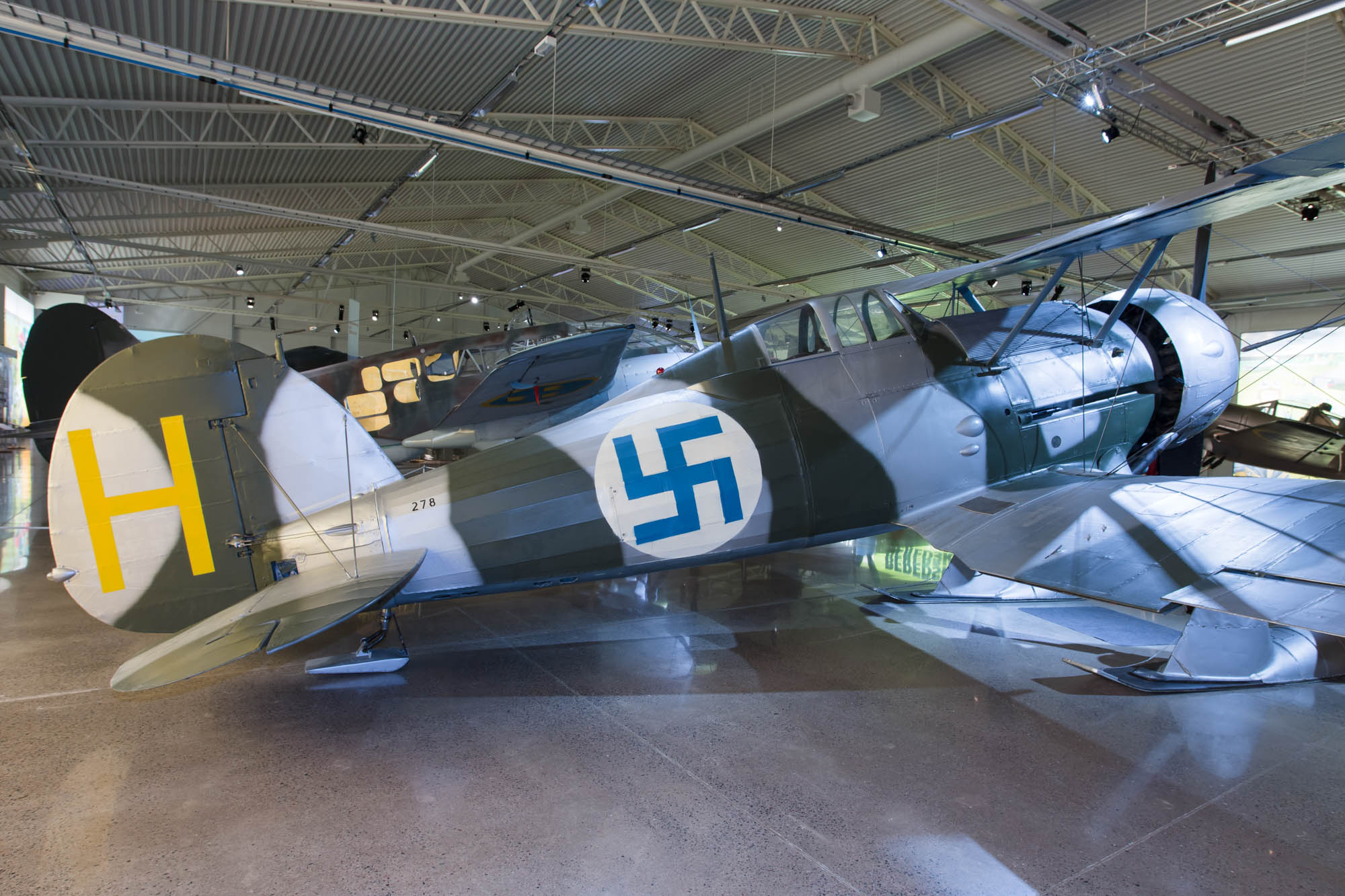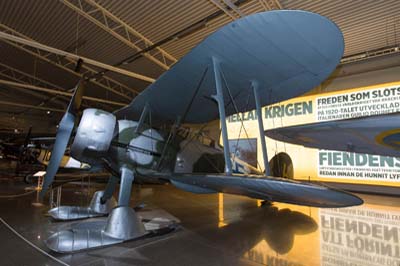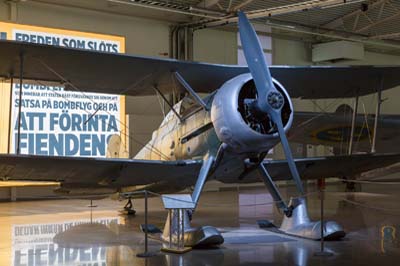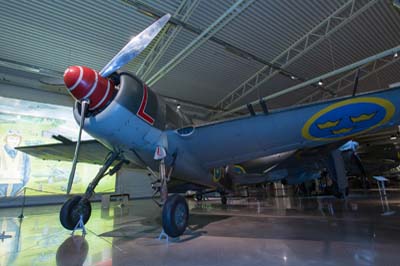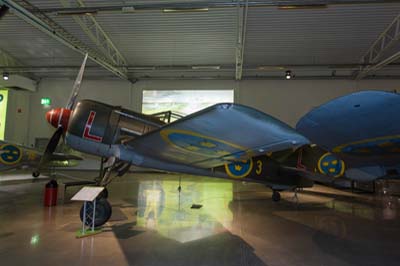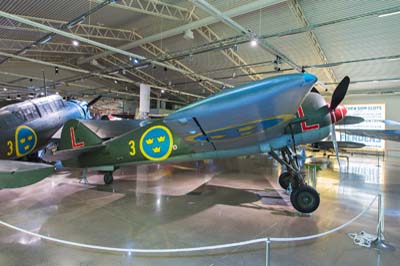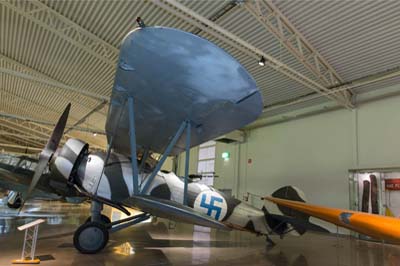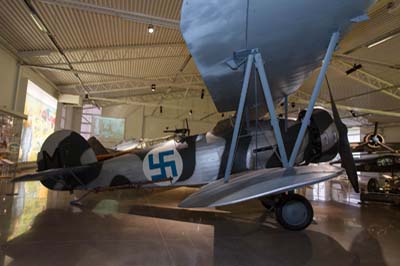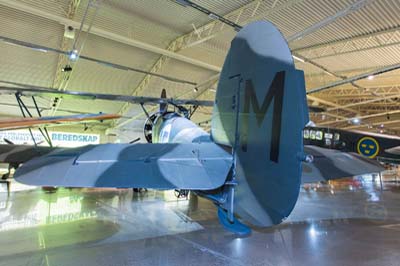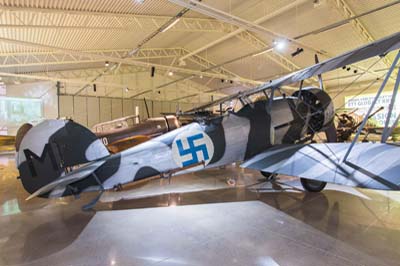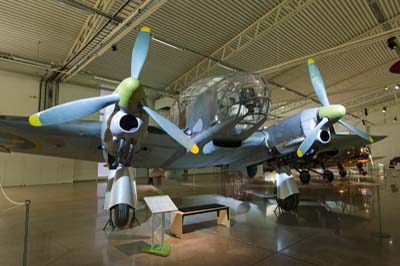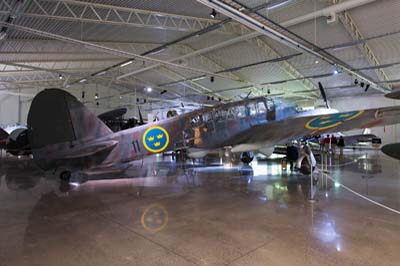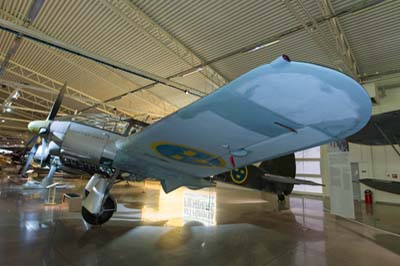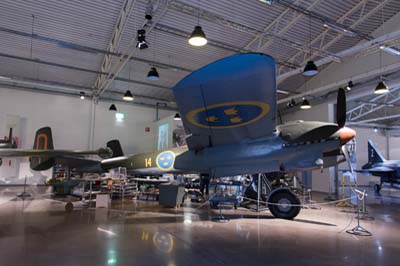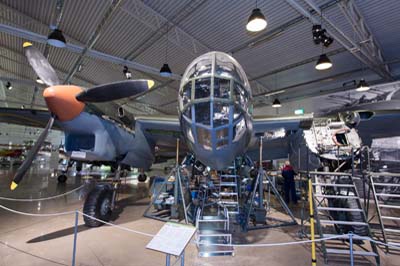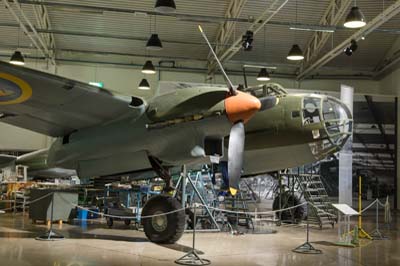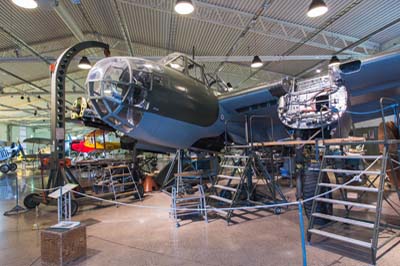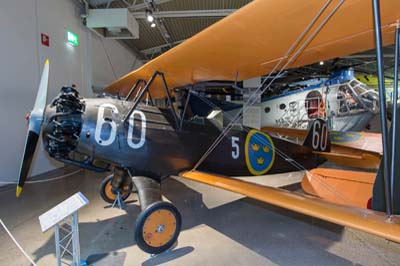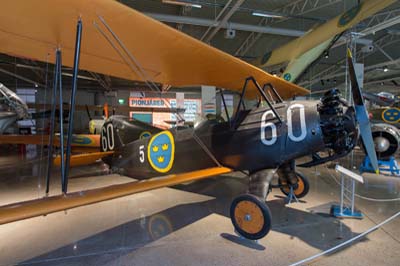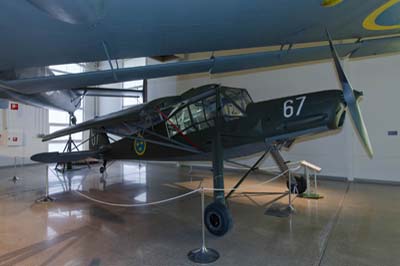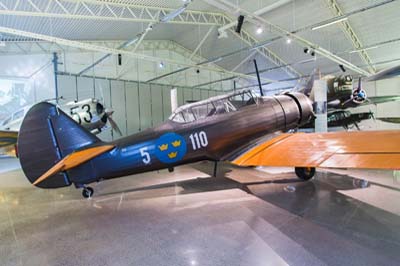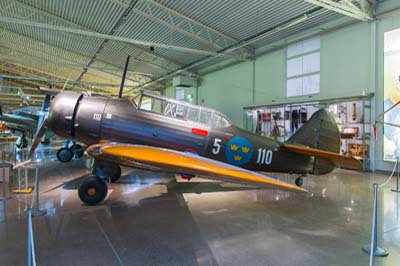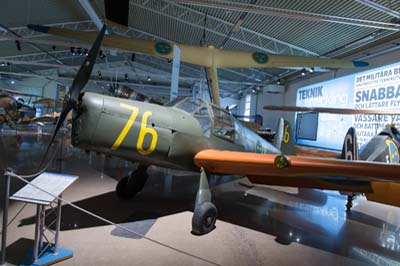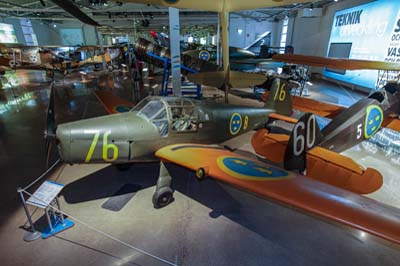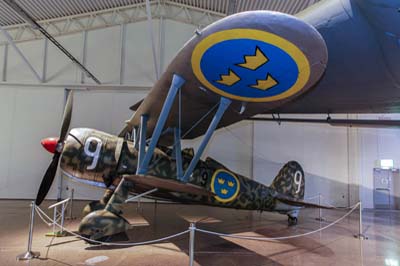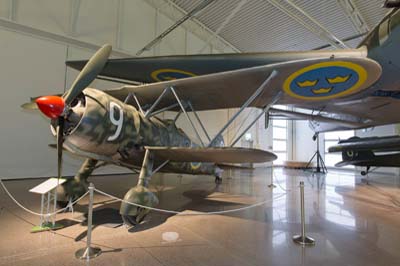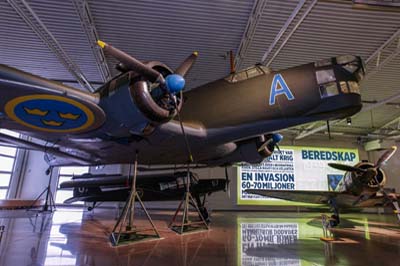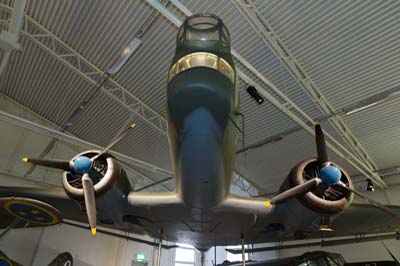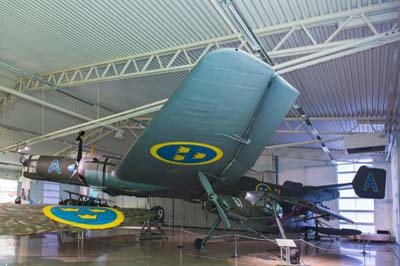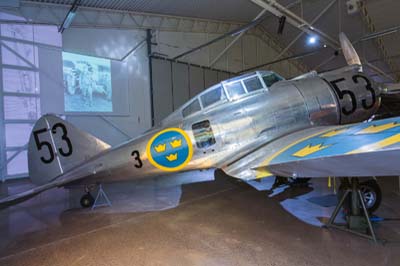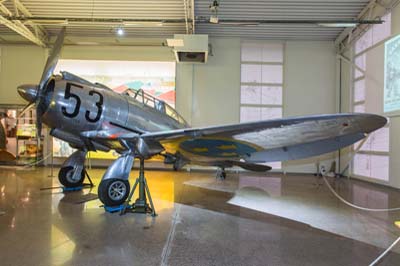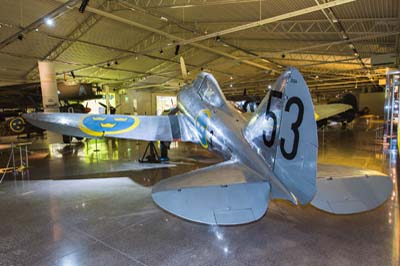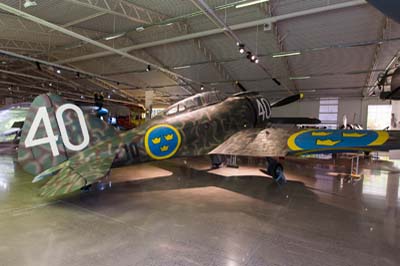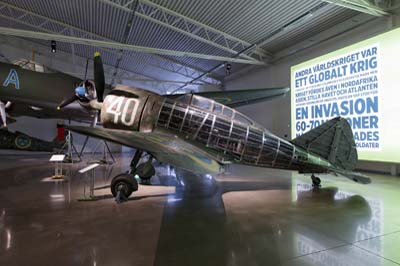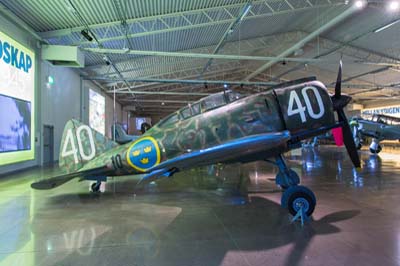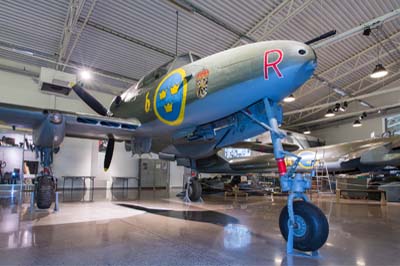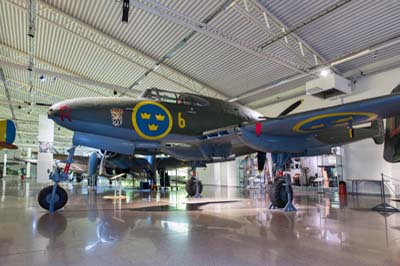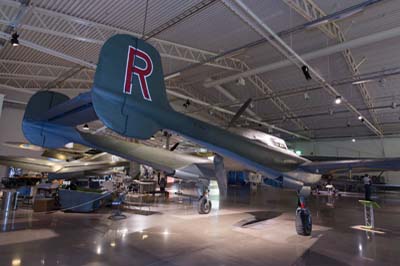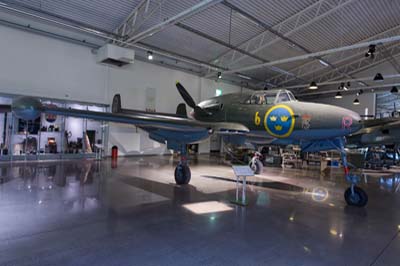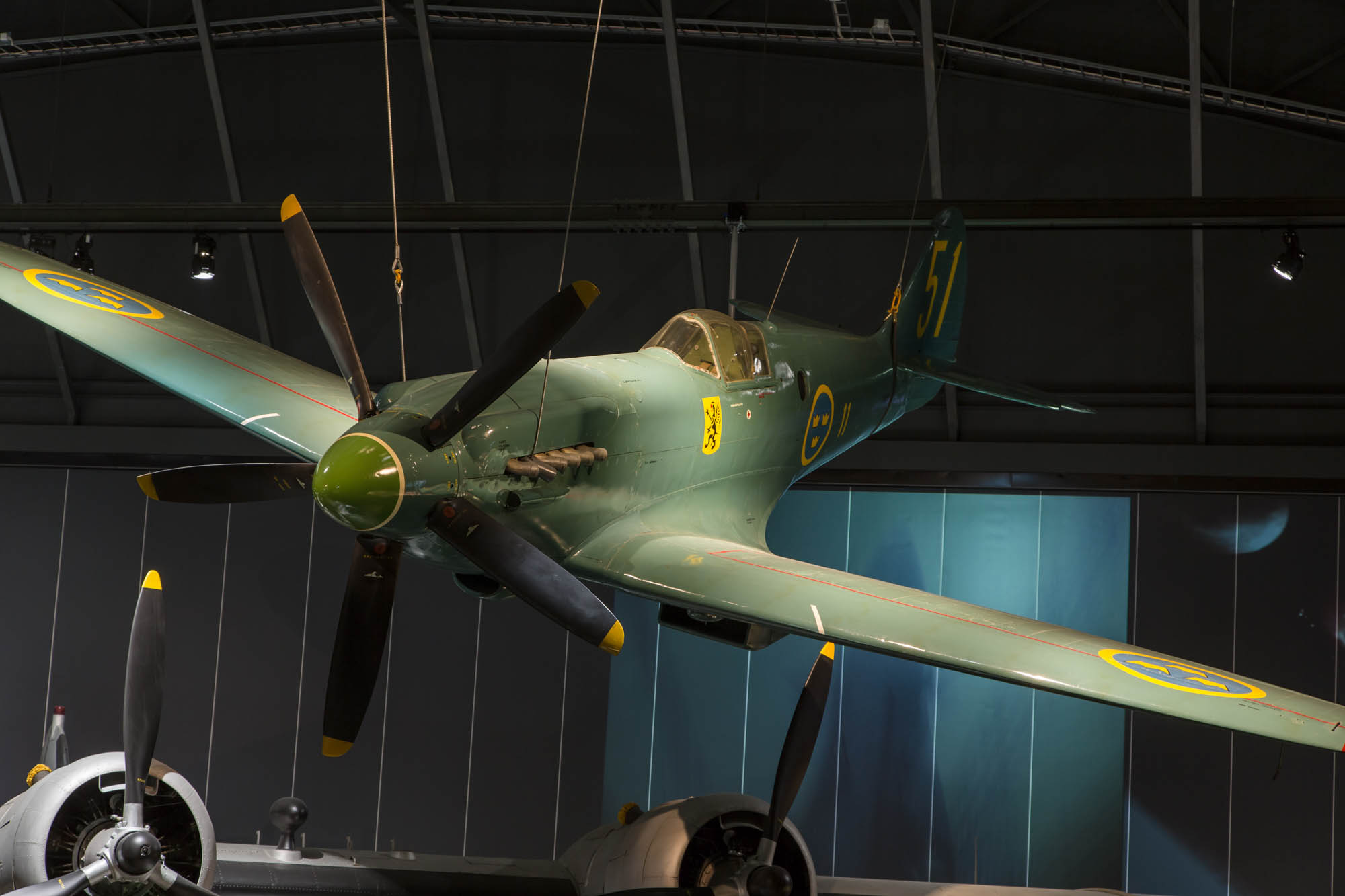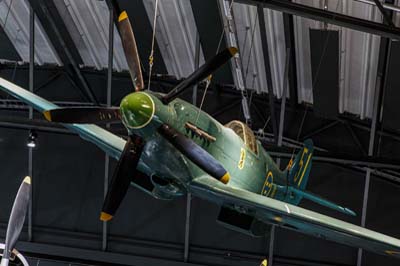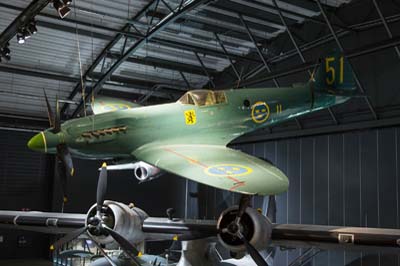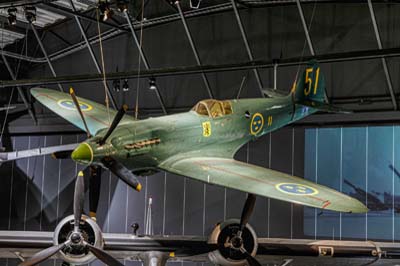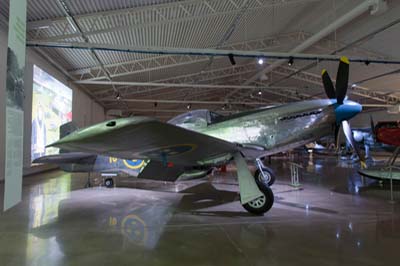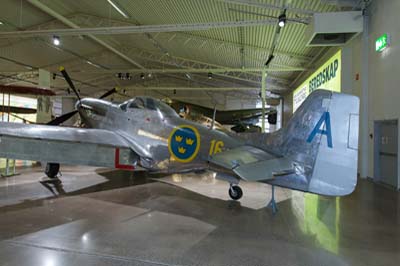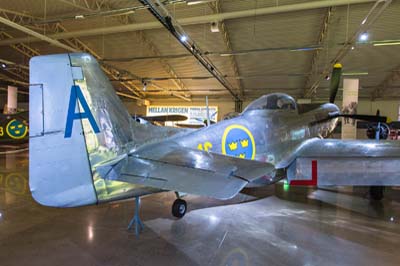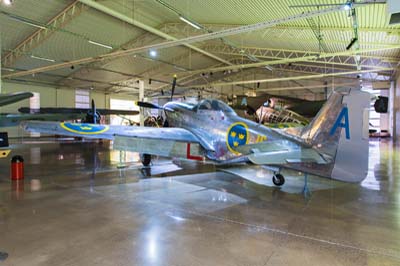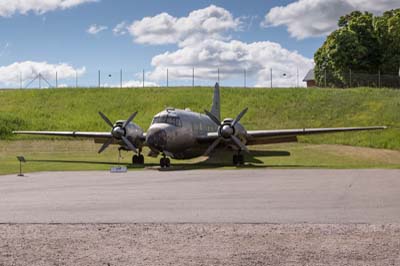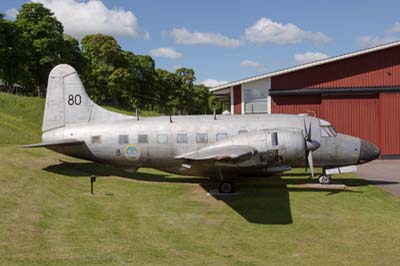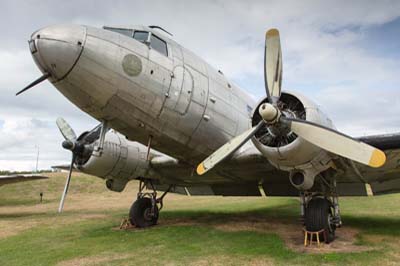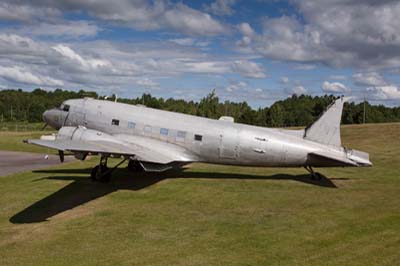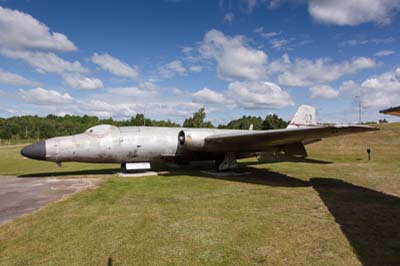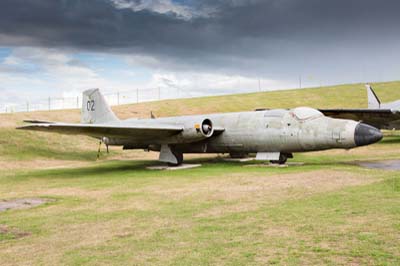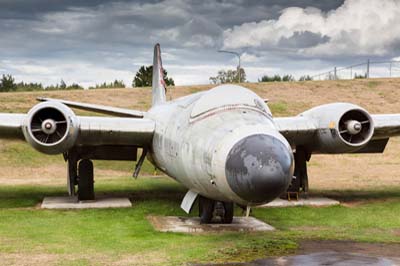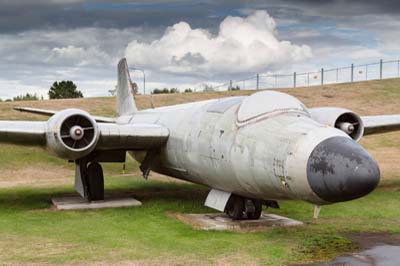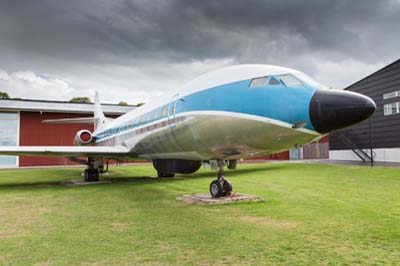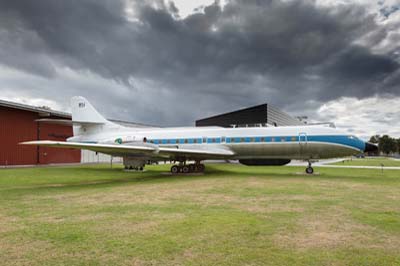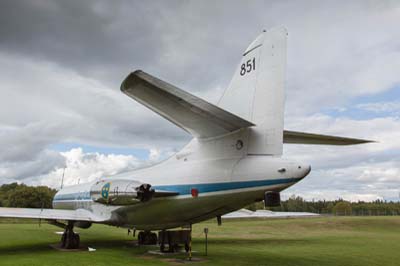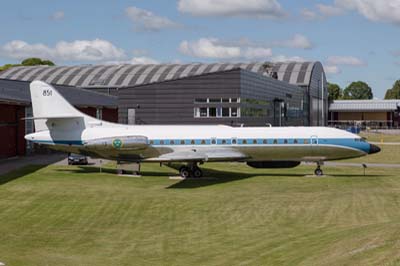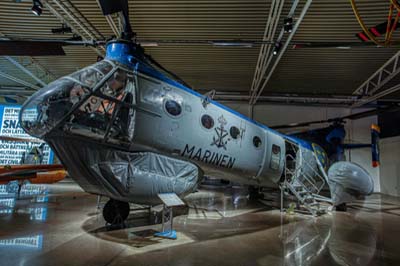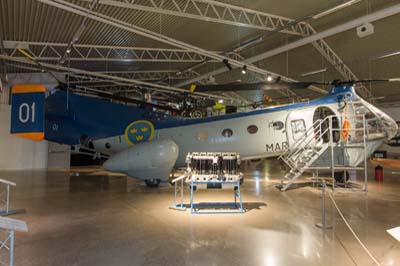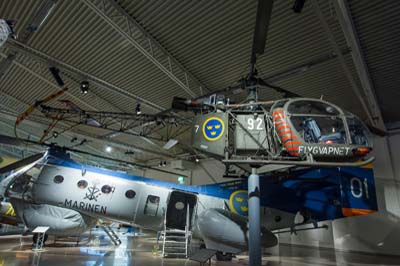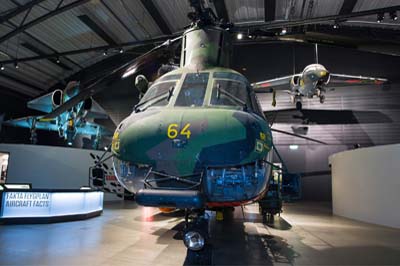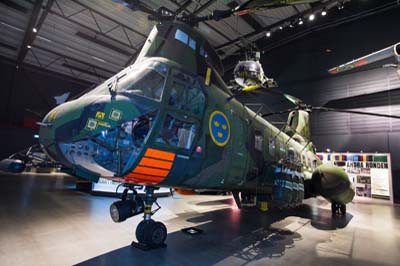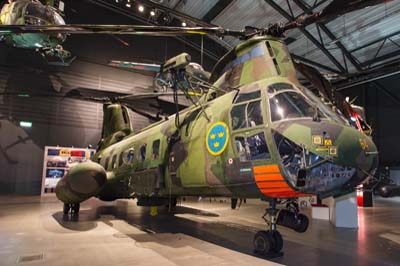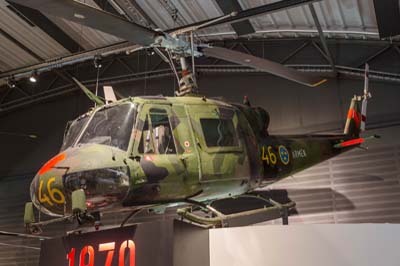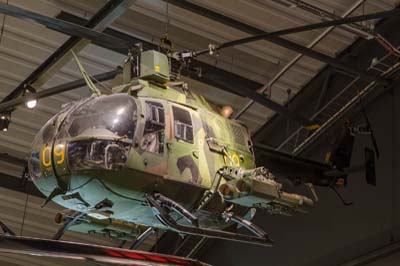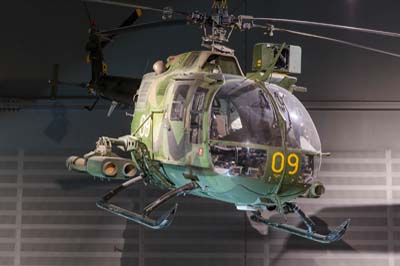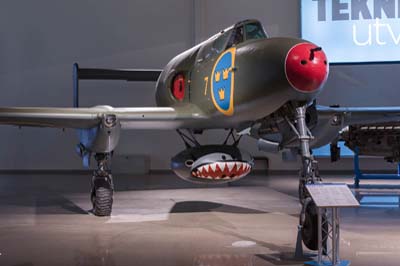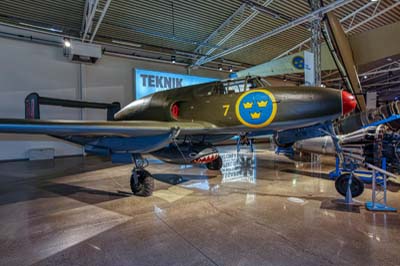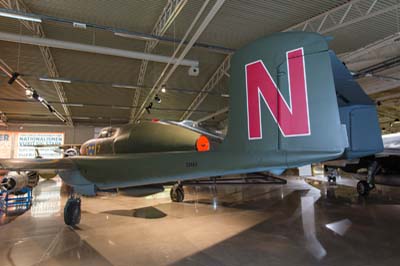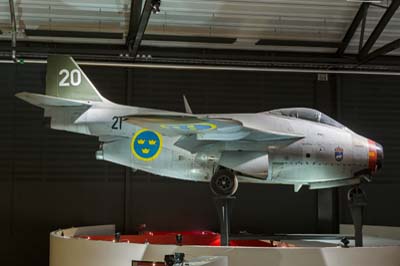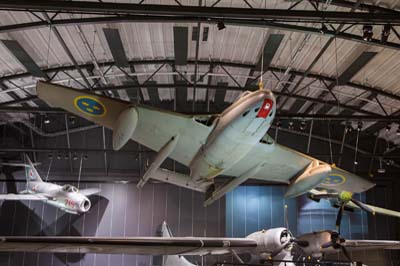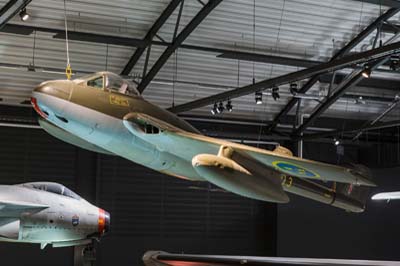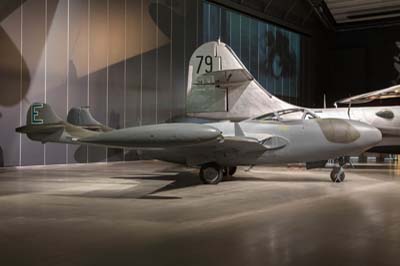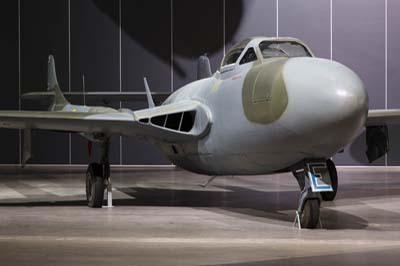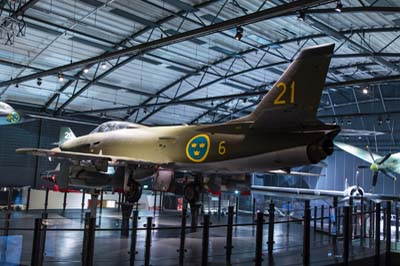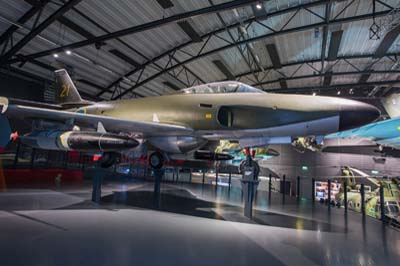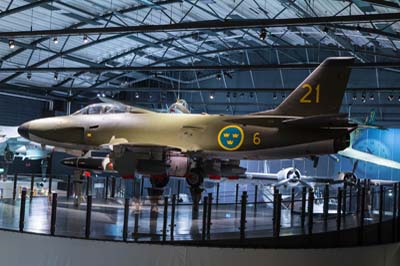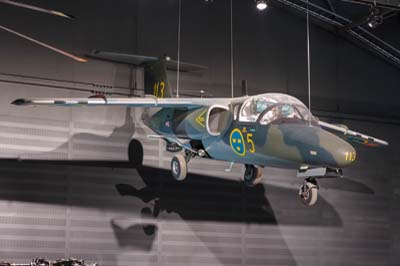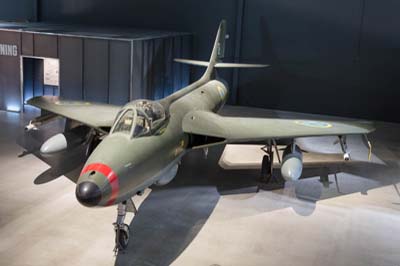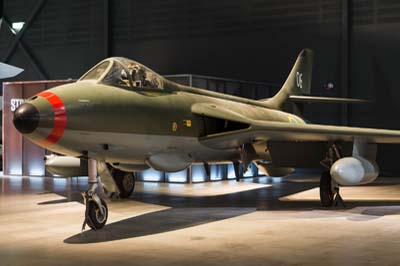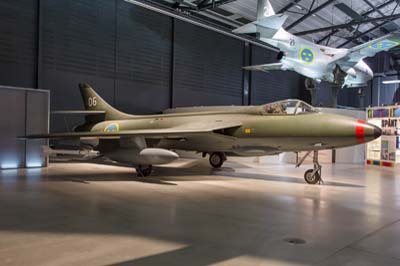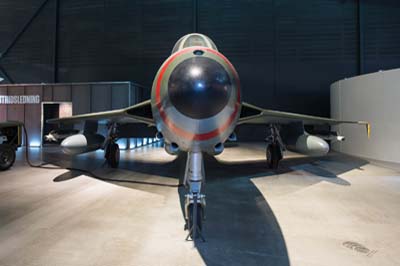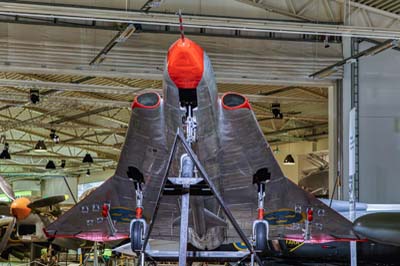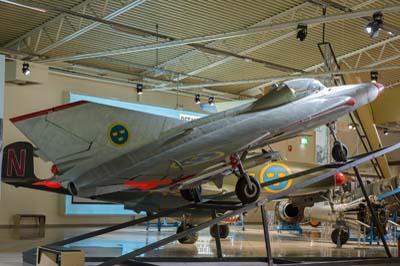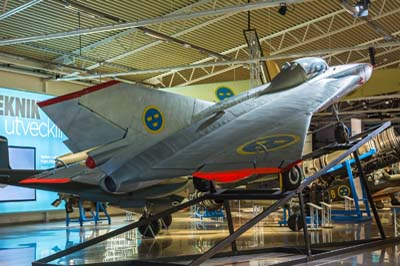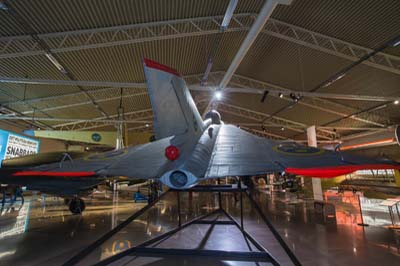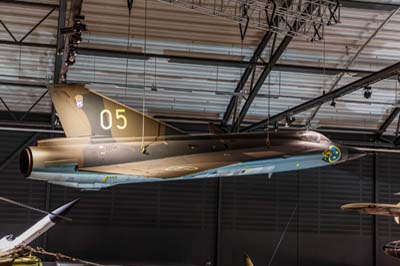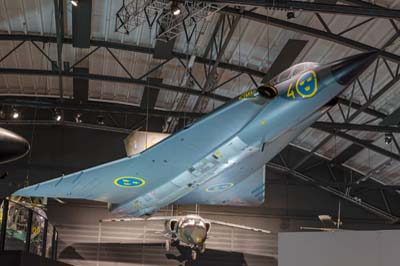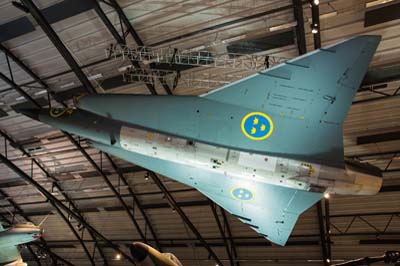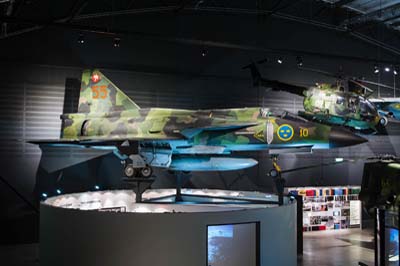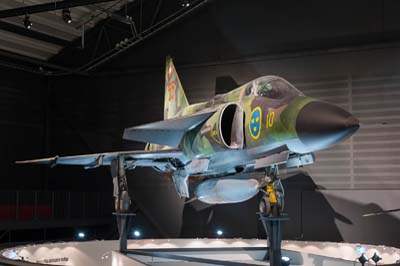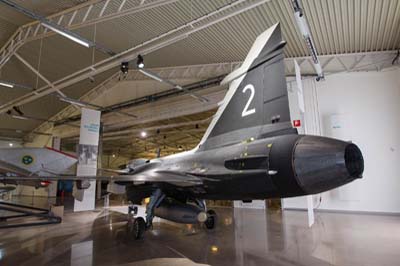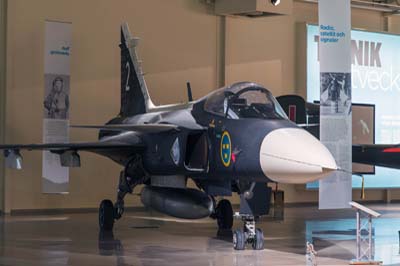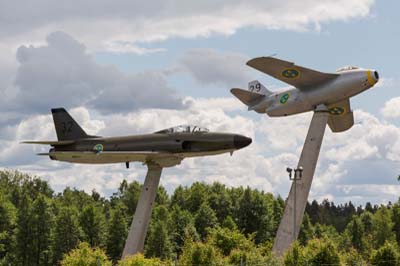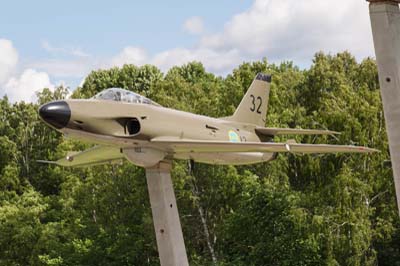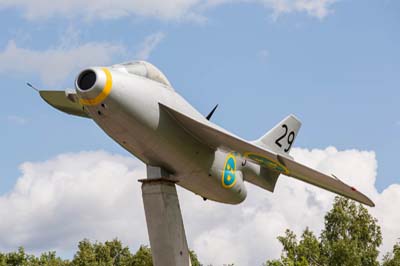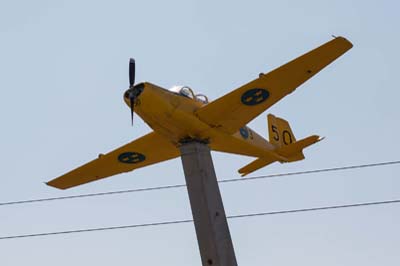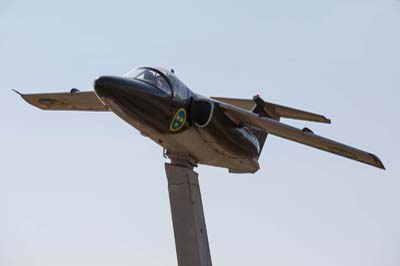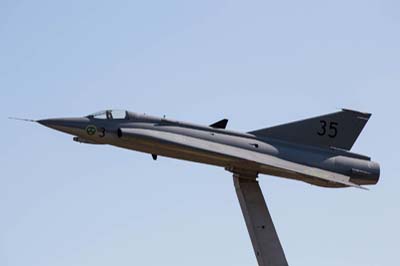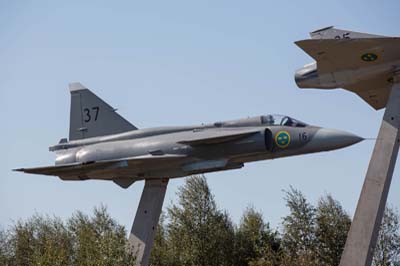Swedish Air Force Museum
(Flygvapenmuseum)
Malmslätt-Linköping, Sweden
June 2013 and August 2014
|
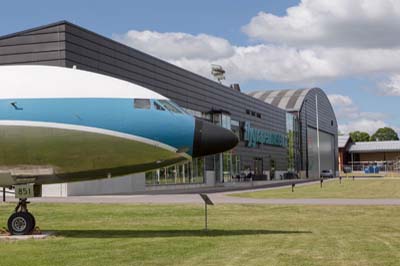 The Swedish Air Force Museum (Flygvapenmuseum) was established in 1977 and formally opened in 1984 by King Karl XVI Gustaf, previously it had been the F 3 squadrons own museum from 1967 at their Malmen air base in Linköping. A second hall was made available for the opening and now the Swedish Air Force's extensive collection of very unique aircraft was put on display.
The Swedish Air Force Museum (Flygvapenmuseum) was established in 1977 and formally opened in 1984 by King Karl XVI Gustaf, previously it had been the F 3 squadrons own museum from 1967 at their Malmen air base in Linköping. A second hall was made available for the opening and now the Swedish Air Force's extensive collection of very unique aircraft was put on display.
Further expansion was completed in 2010 when additional Government money was made available to house the wreck of the recently recovered DC-3 which had been shot down by a Soviet MiG-15 over International waters during the Cold War in 1952. The DC-3 had been found deep in the Baltic Sea 50 kilometres east of the Gotska Sandön Island, over 50 years after it had been forced down and was now been put on display and in a very stunning and moving way. In the darkened basement of the new building the crumpled DC-3 wreckage is displayed in a glass case with red and blue lighting. Haunting background music is playing continuously and the full story is displayed on boards around the room. The whole effect is remarkably moving and is an outstanding tribute to the eight airmen who were lost and to the suffering of a peace loving nation during the Cold War. |
| The DC-3 that disappeared |
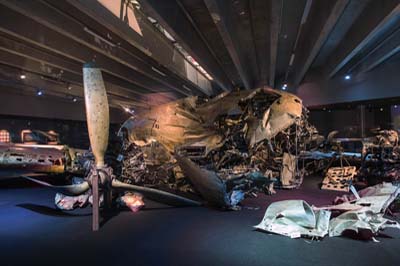
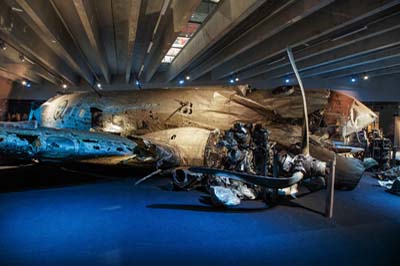 On June 13, 1952 the DC-3 took off from Bromma in Stockholm on an Electronic Intelligence (ELINT) gathering radio eavesdropping mission over international waters in the Baltic. Two hours later communications were lost. No trace of it was found apart from a deflated dinghy with traces of Soviet ammunition. It was at the height of the Cold War when tensions were high between East and West. The mapping and assessment of the Soviet's system was important for Sweden's defence.
On June 13, 1952 the DC-3 took off from Bromma in Stockholm on an Electronic Intelligence (ELINT) gathering radio eavesdropping mission over international waters in the Baltic. Two hours later communications were lost. No trace of it was found apart from a deflated dinghy with traces of Soviet ammunition. It was at the height of the Cold War when tensions were high between East and West. The mapping and assessment of the Soviet's system was important for Sweden's defence.
A Soviet MiG-15 had been ordered to shoot the DC-3 down using 23mm and 37mm automatic cannon. The port engine oil tank was hit causing a severe fire. The Soviet Union did not admit liability for the shooting down until the 1990s.
The aircraft was found 410 feet (126 meters) from the surface in 2003. A search and salvage operation was conducted over 50 years after the DC-3 was lost. On March 19, 2004 it was finally brought to the surface along with the remains of four of the eight crew members.
It was then discovered that the DC-3 had impacted with the sea with great force the engines had been torn from their mounts, the cockpit crushed and the left wing torn off. The left and right tail plane had folded up against the tail fin. The fuselage despite the corrosion from over fifty years on the Baltic Sea bed shows signs of shell holes with the metal bent inwards. Exposed to oxygen the decay of the metal was accelerated to prevent this it has been treated with a rust inhibitor which has given it a golden brown colour. |
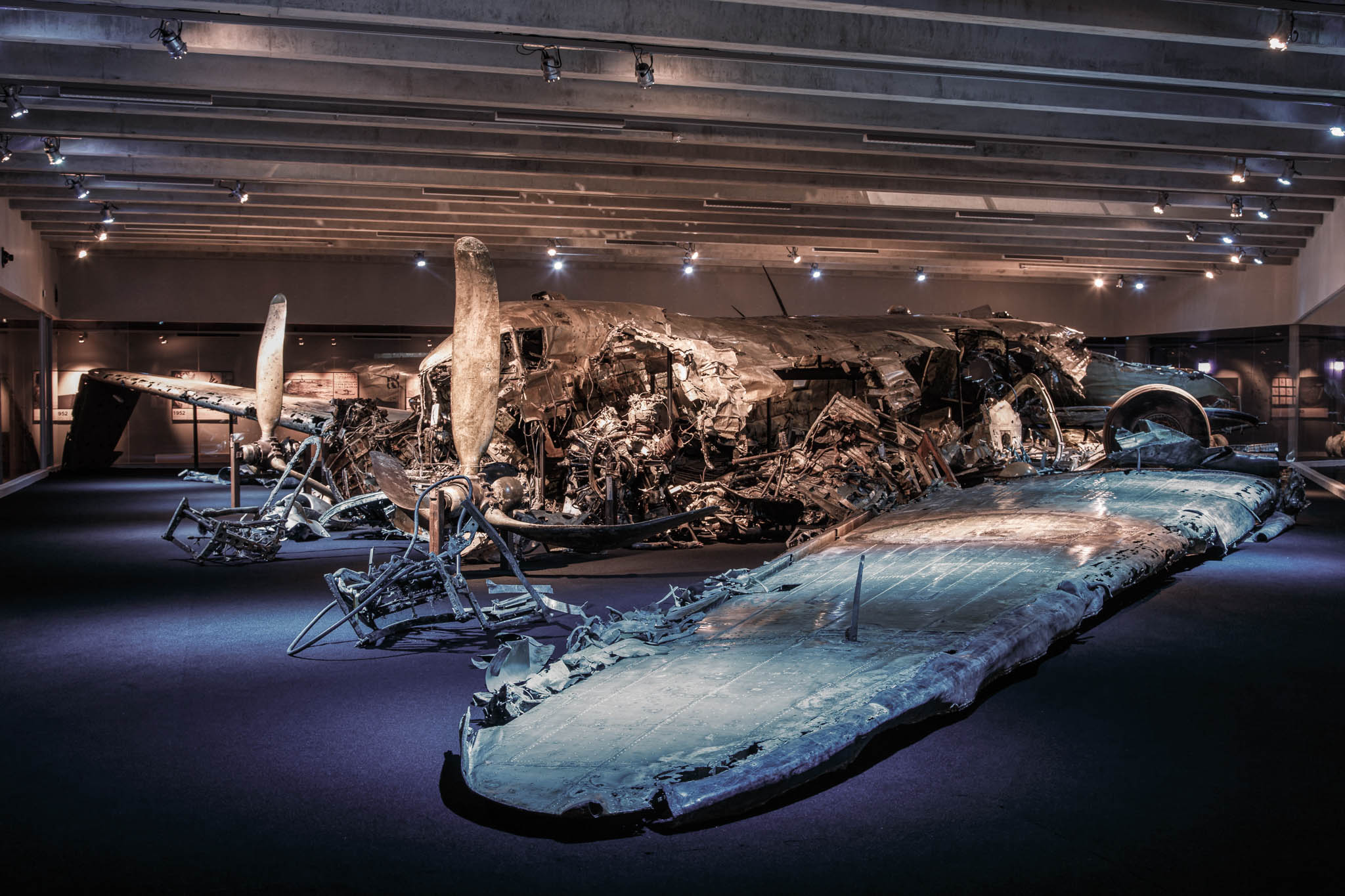 |
| Douglas Dakota DC-3 / Tp79 (79001) salvaged after 52 years from the Baltic Sea. |
Left to right:
Consolidated PBY-5A Catalina / Tp47 (47001 '79') This amphibious seaplane served in Sweden from 1947 to 1966. It was used for air-sea rescue operations and was capable of remaining airborne for 18 hours or even 24 hours with external tanks fitted. During the search for the missing DC-3 in June 1952 an unarmed Tp47 Catalina was shot down by two Soviet MiG-15s but was able to make an emergency landing on the sea.
PZL-Mielec Lim-2 (Mikoyan-Gurevich MiG-15bis) (Really ex Polish Air Force 215 c/n 1B00215) It is estimated that over 12,000 of the post war jet fighters were built by the Soviet Union during the Cold War. Its design is influenced by the plans seized from the Germans at the end of the World War Two of the Messerschmitt P.1101 which never flew, also of similar design came the J29 Tunnan and F-86 Sabre. It was a Soviet MiG-15 which shot down the Swedish Air Force DC-3 Dakota in June 1952 and a Tp47 Catalina which attempted to search for the missing aircraft and crew. |
| Inside the Swedish Air Force Museum |
| Left to right: The new 2010 building with helicopters and fast jets from the 1950s onwards. Priceless pre-war exhibits lined up in the main hall. |
| From the earliest days of the Swedish Army Air Corps to the formation of the Swedish Air Force in 1926. |
Left to right:
Nieuport IV-G / M1 (-) This is one of the first two aircraft to enter service with the Swedish Army Air Corps. It was bought to compare the characteristics of a mono-plane with a bi-plane, the result from which it was hoped would dictate future purchases. Lt Gösta von Porat received flight training at the Nieuport factory in France in 1912. The aircraft however suffered from numerous technical problems mostly with the engine. The sole M1 flew until 1919 and appeared at an air show at Göteborg (Gothenburg) in 1923 before its transfer to the Flight-Historical collection at Malmen. For the 50th anniversary of Swedish military flight in 1962 the aircraft was restored and flew for one final time.
Replica Bréguet C.U-1 / B1 The B1 was the bi-plane purchased in France used to test the double-wing concept in 1912 against the Nieuport IV-G monoplane. The B1 also suffered from mechanical failure and accidents until it was written off in 1915. This replica had taken 12 years to complete when it was handed over to the museum in 1989. The engine, tail assembly and radiator are all original however. |
Left to right:
Thulin G (15) Five aircraft were ordered in 1915 from AB Enoch Thulins Aeroplanfabrik (AETA) in Landskrona and delivered in the following year. The World War One delayed the delivery of the German engines and the first flight did not take place till 1917. Two aircraft crashed in 1918 and 1920 another was destroyed by fire in 1921. The remaining two Nos. 15 and 19 were withdrawn in 1922. The Thulin G served with the Swedish Naval Air Service and was used to patrol Sweden's neutral coast line and observe foreign shipping.
The example on display flew from 1917 to 1922 and was later handed in pieces to the Technical museum in Stockholm in 1934. In 1982 it made its way to the Swedish Air Force Museum collection and was only reassembled and renovated by the Swedish Flight-Historical Society in 2010. |
Left to right:
(Övningsflygplan) Ö1 Tummelisa (3656) In 1919 aviation pioneer Gösta von Porat when in Paris sketched out a design for an advanced trainer. The Swedish Army already had a number of Thulin engines and with aviation engineer Henry Kjellson they designed the Ö1 Tummelisa at Malmen. In June 1920 it made its first flight, as it was not easy to fly it was only used by the advanced pilots.
On display is the only surviving Ö1 Tummelisa, built in 1928 it flew with F5 at Ljungbyhed and later with F 3 at Malmen. For the 50th Anniversary of Swedish military aviation in 1962 it took to the air a final time. |
Left to right:
Albatross B.11 / Sk1 (464/04). the Albatross was built in Germany as a twin-seat trainer and reconnaissance aircraft. During a flight from Germany to St.Petersburg in 1919 an Albatross B.11 suffered damage to its propeller and was forced to land at Stockholm. Before repairs could be completed the World War One broke out and it was impounded. It was eventually bought and it became the sixth aircraft to enter service with the Swedish Army (Armén) as the Sk1 trainer. Later modified to have dual controls it was decided to produce 40 copies in workshops around Sweden. In 1919 the Royal Swedish Navy (Marinen) bought five aircraft from Germany.
The Albatross B.11 on display was built in 1925 at Malmen for the Army Air Corps and given the number 464. When the Royal Swedish Air Force was formed in 1926 it was designated as the Sk1 and given the number 04. Stationed at F5 Ljungbyhed it flew until 1929 and held in the Flight-Historical collection having flown a total of 682 hours.
|
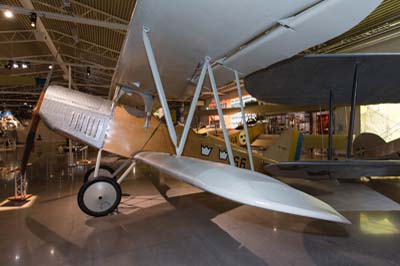 |
 |
Left to right:
Heinkel HD 35 / Sk5 (66 c/n 235 later SE-SAM). The HD 35 was bought for assessment in 1925 at F5 Ljungbyhed as a basic trainer but was found to be under-powered, Following a crash in 1930 it was sold to a civilian and registered SE-SAM and later flew again until 1940. The more powerful HD 36 designated Sk6 was accepted and served with the Air Force from 1927 till 1940.
The only Sk5 numbered 66 was deregistered in 1940 and miraculously languished in a barn in Småland until its discovery in 1964 and finally was acquired by the museum in 1987. |
Left to right:
Phonixjagaren 122 D.11 / J1 (947) In 1919 two Austrian pilots displayed the Phonix C.1 Reconnaissance variant with the D.111 fighter variant. Both aircraft were bought by the Swedish Army for evaluation. In 1926 the Swedish Air Force was formed with an order of 30 Phonix D.11 fighters ten of which were built under license. It was their first fighter and was given the designation J1.
The example on display was one of the first bought for the Army arriving in 1920 it was transferred to the Air Force in 1926. Considered obsolete in 1928 it was withdrawn to the Flight-Historical collection at Malmen. |
Left to right:
de Havilland DH.60T Moth / Sk9 (5558 '58' later registered SE-BFI) de Havilland designed the Moth from the 1920s as an aircraft to meet the needs for the fast growing aero clubs and private pilots. In 1926 they re-engine the Moth with the new de Havilland Gypsy engine. In 1931 the Swedish Air Force received its first Sk9 Moth for pilot basic training, these were flown until 1938. The Sk9H version was equipped with floats so that it could operate from land and water.
The example on display arrived at F5 Ljungbyhed in the summer of 1931. In 1947 it was sold and became SE-BFI. Following restoration it was donated to the Swedish Air Force Museum Trust for Flygvapenmuseum's opening in 1984.
RAAB-Katzenstein RK-26 Tigerschwalbe / Sk10 (536 '101'). It was ordered from the German manufacturer in 1931 as a template for license built examples to be manufactured by AB Svenska Järnvägsverkstädernas Aeroplanavdelning (ASJA - Swedish Railroad Workshops Air Plane Department) at the plant at Linköping. The Swedish Air Force ordered 25 aircraft for flight training. However modifications made by ASJA were detrimental to its flight characteristics and 18 of the 25 were lost in accidents the survivors were withdrawn in 1945.
The example of display was delivered in 1934 to F5 at Ljungbyhed and later went to F1 at Västerås before its retirement in 1944 it is the only surviving Sk10. |
Left to right:
Fokker C.V-E / S6 (386 '86'). The C.V was built in the early 1920s by Anthony Fokker as a two-seat reconnaissance and bomber aircraft. Construction allowed to five variants to be ordered with different wing spans and a choice of landing gear, either wheels to pontoons.
The Royal Swedish Air Force was formed in 1926 and bought two C.V-E reconnaissance and two C.V-D fighters for testing. Later 12 more were purchased from Fokker in Holland and 35 others were built under license by Centrala Verkstäderna (Central Works) at Malmen. The C.V-D or J3 was unsuccessful as a fighter and eight aircraft were re-designated J6 for reconnaissance role. For increased versatility it could be fitted with skis and floats.
This example was built at Malmen in 1934 and served with F 3 before its retirement in 1945. It was subsequently renovated in 1962 for a 50th anniversary and made its last flight the following year to Holland and back for a jubilee. |
| Sweden Air Force during World War Two. |
| Gloster Gladiator / J8 (278 'H') when serving with F19 in Finland in the 1939-40 Winter War. |
Left to right:
Gloster Gladiator / J8 (278 'H') Already obsolescent when the Swedish Air Force took delivery of the Gladiator it was still the Swedish Air Force's first purpose built fighter aircraft and the first with an enclosed cockpit. By 1943 they were only used in the training role. Twelve examples equipped with skis were used in the 1939-40 Winter War in Finland by F19 the Swedish voluntary wing. 55 examples had been purchased from England and these were first operated by F8 at Barkaby, Stockholm.
The example on display was one of the original twelve to serve with F19 in Finland returning home to F10 Ängelholm in March 1940, it was withdrawn from service in 1945 having flown 699 hours. |
Left to right:
FFVS J22 (22280 'L') With the outbreak of the World War Two the Swedish Air Force had to strengthen its Air Force, purchasing aircraft from outside Sweden was difficult so a design of a fighter aircraft sketched out by Bo Lunberg when in the USA was selected for construction by the newly formed FFVS company. The first flight of the 198 built was made in 1942.
The example on display was delivered to F8 at Barkaby in May 1945 and later was transferred to F18 at Tullinge before its retirement from service in 1952 when it moved to the care of the Flight-Historical collection at Malmen. |
Left to right:
Hawker Hart / B4 (714 'M') 45 examples were received by the Swedish Air Force, originally purchased for reconnaissance duties it was designated S7 but re-designated B4 when it was employed as a dive-bomber during the 1930s. Five of these aircraft were utilised during the winter war of 1939-1940 in Finland under the F19 voluntary wing. Skis could be fitted to enable them to land on ice and snow.
The example on display was built under license by ASJA in Linköping in 1937 and delivered to F1 at Västerås. In 1947 it was withdrawn and sent to the Flight-Historical collection at Malmen for preservation. Although painted in the colours of the Finnish Air Force, it was not one of the five to serve in Finland. |
Left to right:
Replica Caproni Ca313 / B16 (-) built for a television series in 1988 using the original drawings and some original parts. During the early 1940s Caproni in Italy delivered 84 Ca313s to bolster Sweden's air force. Unsuccessful as a fighter-bomber the B16s were later modified for long range reconnaissance duties. |
Left to right:
SAAB 18 / B18B (18172 'D') This is the second aircraft type designed by SAAB it's first flight was made in 1942. 243 were built in the bomber (B18), reconnaissance (S18) and torpedo and mine laying (T18) versions. The T18's role was changed and the designated aircraft were fitted with a 57mm cannon.
The aircraft on display force landed on ice in Harnosand harbour in 1946 and sank two days later. It was salvaged in 1979 and restored by the Östergötland Flight-Historical society it is the only surviving B18. |
Left to right:
Focke-Wulf Fw 44J Stieglitz / Sk12 (670 '60' registered SE-EGB) Designed as a two-seat trainer it flew for the first time in 1932. In 1935 they tested two aircraft and followed up with an order for 85 more to be built under license until 1943. They continued in service until the 1950s as trainers with three continuing to serve as glider tugs till the late 1960s.
The aircraft on display was built in 1941 and flew until 1967 ending its days as a glider tug with the civil registration SE-EGB. It's last flight was made in 1976 for the Swedish Air Force's 50th anniversary.
Fieseler Fi 156C-3 Storch 'Stork' / S14 (3812 '67'). The Storch was designed in 1935 and widely used by German military forces throughout the war. More than 2,900 were put into service between 1939 and 1945 as light transports and as air ambulances. During the war the Fi 156 was produced in Germany and in occupied countries. It was built at the MRAZ factory, in Czechoslovakia and in France by Morane-Saulnier at Puteaux. Post war two versions were built in France, the MS.500 with the Argus in-line and the MS.502 with a Salmson radial. It is highly manoeuvrable with an extremely low stalling speed. It can take off in less than 200 feet at just 25 mph.
The Swedish Air Force acquired 26 examples in three versions. With skis attached it could land on ice and snow and as such when stationed at Kiruna they were used to rescue refugees from German occupied Norway during the winter of 1944-45. Following their retirement in 1961 all remaining aircraft were sold in Germany and Austria.
The Fi 156 on display is a composite was bought in Austria in 1967 by Östergötland Flight-Historical Society for the museum and reassembled at Malmen with the parts of at least two others. |
Left to right:
North American NA-16-4M / Sk14 ('610 / 110') at the end of the 1930s Sweden received two NA-16s and obtained a license for ASJA in Sweden to build 35 more of the trainers. These were delivered to the flying school at F5 Ljungbyhed. Additional aircraft were built by SAAB in 1937 which was then formed following the merger of several aircraft companies including ASJA. They served with the Swedish Air Force until 1947. No Sk14s have survived, the aircraft on display is a composite replica completed in 2003 from various parts including an Australian Wirraway and Canadian Yale.
Bücker Bü 181B-1 Bestmann / Sk25 (25000 '76') this two-seat side by side trainer was designed in Germany at the end of the 1930s by Swedish engineer Anders Johan Andersson. Production ran from 1940 to 1945, in 1942 the Swedish Air Force ordered an example for evaluation and subsequently signed an agreement for its manufacture under license. From 1944 to 1946 116 Sk25s were delivered to F4 at Ljungbyhed.
The example on display is the original Bestmann (German Air Force serial EX+WB) bought in 1942. |
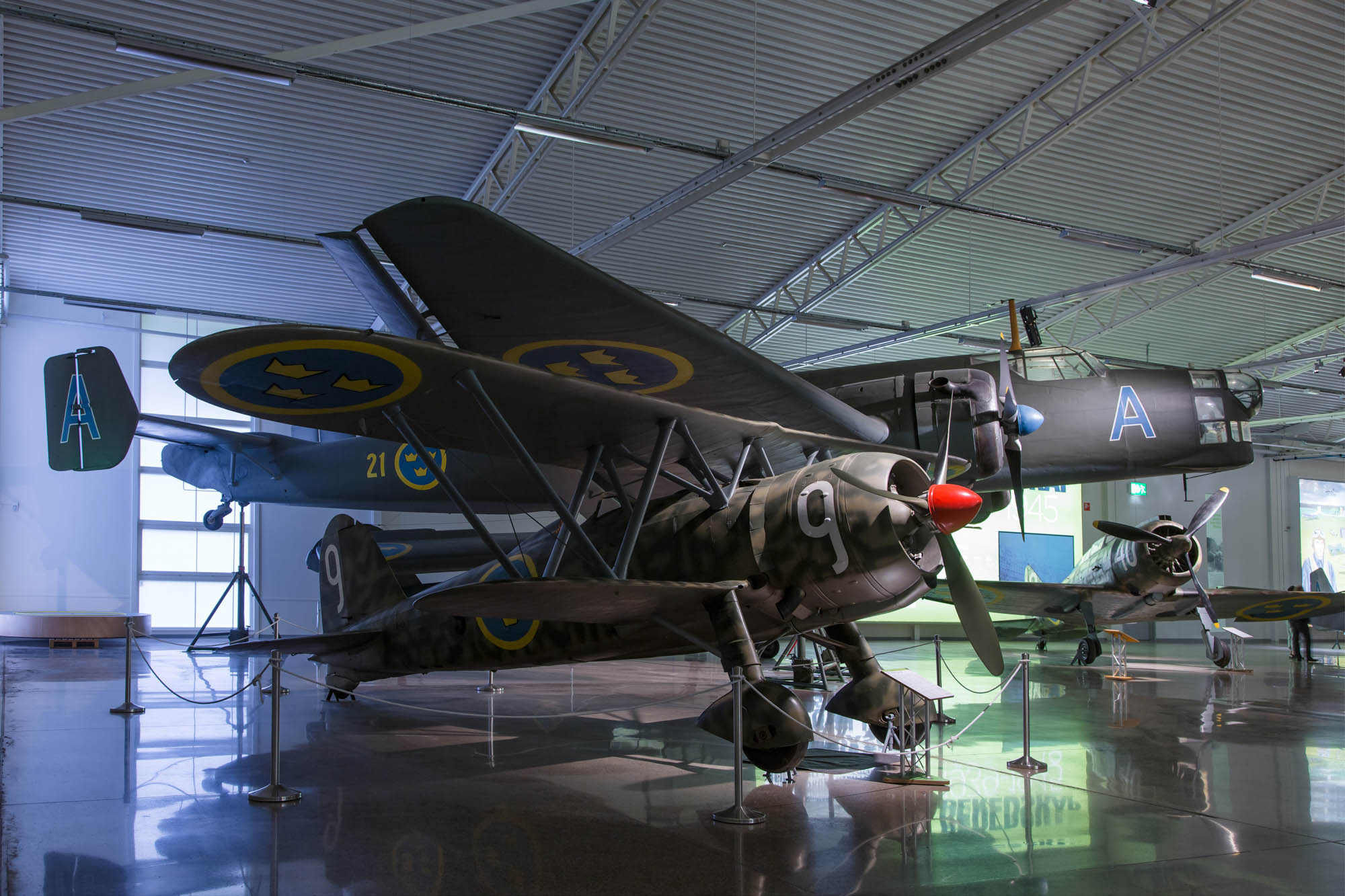 |
The very rare Fiat CR.42 'Falco' / J11 and only surviving Junkers Ju 86K / B3
|
Left to right:
Fiat CR.42 'Falco' / J11 (2543 '9'). 12 aircraft were ordered from Italy as the threat of war increased in 1939, a further 60 were later acquired as fighters and reconnaissance aircraft. This example entered service in May 1942 and was soon retired in 1945 when with F9 at Säve. The museum's example is one of the only three CR.42s that still exist today. see CR.42 at Vigna di Valle and CR.42 at Hendon. |
Left to right:
Junkers Ju 86K / B3 (0155 'A') An initial 40 examples were ordered from Junkers in 1936 with a licensing agreement for SAAB (Svenska Aeroplan Aktiebolaget) to manufacture additional aircraft at their plant at Trollhättan. Built as a medium weight bomber it could also be converted to carry torpedoes, later a number were converted to transports. The example on display was built in Germany in 1938 and delivered to F1 at Västerås in June 1938. As a transport aircraft it was operated by F 21 at Luleå. Following its final flight in 1958 it had flown 2,086 hours and is the only surviving Ju 86 in the world. |
Left to right:
Seversky/Republic EP.106 / J9 (2134 '53'). With the threat from Germany the Swedish Air Force ordered 60 of these fighter aircraft, the first of which were shipped to Trondheim in Norway in early 1940 and following the German occupation of Norway in April of that year the remainder were shipped to the then Finnish port of Petsamo in the Arctic. They were then transported to Malmen for assembly and service as a fighter and reconnaissance aircraft. In 1948 this aircraft was retired after flying 820 hours. |
Left to right:
Reggiane Re.2000 Falco 1 / J20 (2340 '40'). With the threat of war, purchases of military aircraft were not easy. It was still possible however for Sweden to buy aircraft from Italy and in 1939 60 Re.2000s were ordered. Once delivered they were assigned to Bulltofta in Malmo and were tasked with detering would be agressors and were often used to escort foreign aircraft to Swedish airfields for emergency landings during the World War Two.
The aircraft on display was delivered to Bulltofta in August 1942 only to be withdrawn from service in 1945 at the end of the war. It is the only complete example of the only two Re.2000s to survive. |
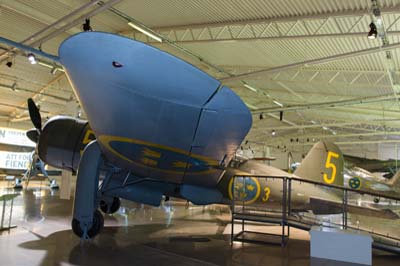 |
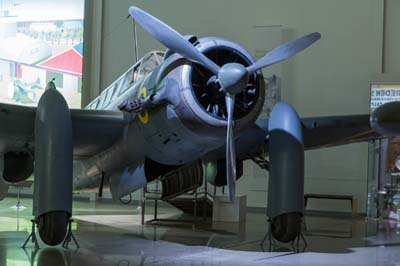 |
Left to right:
SAAB 17 / B17B (17005 '5'). It was designed as a dive bomber and reconnaissance (S17) aircraft and is one of just 323 B17s that were constructed and the first aircraft built by SAAB at Trollhaten, its first flight taking place in May 1940. It's odd looking undercarriage doubles as air brakes in the dive.
The example on display was delivered in 1942 to F 7 at Såtenäs. In 1945 it was converted to the reconnaissance version and moved to F 3 at Malmen. It was retired in 1948 and transferred to the Flight-Historical collection. |
Left to right:
SAAB 21 / J21A (21364 'R') First flown in 1943 this innovative design, with a propeller at the rear, allowed weaponry to be placed in the nose. It was one of the first aircraft to have an ejector seat. 298 J21s served with the air force in fighter and ground attack versions. Four were converted with jet engines designated the J21R.
The example on display flew as a fighter and strike aircraft initially serving with F9 at Säve from August 1948. In 1950 it was with F6 at Karlsborg in the strike role up to it's retirement in 1954 and transfer to the Flight-Historical Society at Malmen. |
| Supermarine Spitfire PR.XIX / S31 |
Left to right:
Supermarine Spitfire PR.XIX / S31 ('31051/51' formally Indian Air Force HS964). 50 of the unarmed photo-reconnaissance version of the Spitfire S31 served with the Swedish Air Force from 1948 to 1955. Fitted with three cameras (two downward and one to the left side) they were used to photograph air bases in Russia during the Cold War. They were replaced by the reconnaissance version of the Tunnan designated S29C.
The Spitfire on display was delivered to the RAF in 1945 (PM627), then sold to India in 1953 (HS964) where it flew for four years before being put on display at the Indian Air Force Museum until 1971 when it was bought by the Canadian Fighter Pilots Association. In 1982 it was exchanged for a large number of surplus Swedish Air Force Museum aircraft and restored over 10,000 man hours. |
Left to right:
North American P-51 Mustang / J26 (26020 'A' ex Israel Air Force 2352 and USAAC 43-63992). Perhaps the best fighter of World War Two, the P-51 Mustang was built from 1940 by North American Aviation to a British specification. Over 15,500 Mustangs were built and following the end of war in 1945 the Swedish Air Force were able to purchase 161 surplus aircraft. These operated from F16 Cadet School, F20 at Uppsala and F4 at Froson. Later twelve aircraft were converted for reconnaissance and operated from F 21 at Luleå. Following the types withdrawal from service in 1954 the remaining aircraft were all sold abroad.
The aircraft on display was received as a gift from Israel in 1966 by the Flight-Historical Society for the museum and was restored in its original colour scheme from when with F16 at Uppsala.
|
Left to right:
Vickers Varsity T.1 / Tp82 (82001 '80') in F8 markings. It was delivered to F8 at Barkarby in 1953 as a transport aircraft and also for use in signals intelligence gathering up to its retirement in 1973.
Douglas DC-3 Dakota / Tp79 (79007 '797') in F13 markings. The Swedish Air Force bought two war surplus DC-3s in 1949 followed by another six, the last of which was retired in 1981. They were used for freight and passenger transport duties and later for signals intelligence gathering. This particular aircraft was built in 1944, by 1945 it was with Norwegian airline DNL before its transfer to SAS in 1948 and later Linjeflyg. In 1960 it was added to the Swedish Air Force fleet. It had flown 30,920 hours before its transfer to the museum. |
Left to right:
English Electric Canberra B.1 / TP52 (52002 '02') in F8 markings. The Swedish Air Force acquired in 1959 two Canberras specifically for signals intelligence gathering they were operated from F8 Barkaby until their retirement in 1974. This aircraft was formally RAF WH905 and was delivered in 1960 for extensive modifications including a large radome and antennas entering service in May 1961. At its retirement it had flown 2,447 hours. |
| Sud Aviation SE210 Caravelle III / Tp85 (85172 '851' ex SE-DAG) in F13 markings. A pair of ex SAS Caravelle IIIs were used from 1971 on ELINT duties with the Swedish Air Force before being replaced with Gulfstream 4SPs in 1998. |
| Helicopters of the Swedish military |
Left to right:
Vertol 44A / Hkp1 (01001 '01'). This was the first helicopter to serve with the Swedish military it entered service in 1958. It was mainly used by the Royal Swedish Navy in the anti-submarine and air-sea rescue role serving until 1972 when it was replaced by the Hkp14.
This helicopter was delivered in 1958 to the naval helicopter squadron at Bromma and flew for the final time in 1971 after 3,094 flight hours, it arrived in the museum in 2011.
Sud Aviation SE.3130 Alouette II / Hkp2 (02406 '92'). Between the end of the 1950s and 1970s over 1,600 Sud Aviation (later Aérospatiale) Alouette IIs were built. All three services in Sweden flew the Hkp2.
The helicopter on display was delivered in 1959 and issued to the army and later it was transferred to the Air Force when it was operated by F 7 at Såtenäs. After 1,033 flight hours it moved to the museum in 1986. |
Left to right:
Vertol 107 / Hkp4 (04064 '64') served with the Air Force and Navy from 1963 to 2010 in a variety of roles including; anti-submarine, air-sea rescue, troop transportation, fighting forest fires etc. |
Left to right:
Agusta Bell AB.204 / Hkp3 03306 '46'). In service from 1962 to 2001 the Hkp3 was used by the Swedish Air Force for all forms of transportation and for search and rescue.
MBB Bolkow Bo-105 / Hkp9 (09209 '09') the Hkp9 was in service from 1985 to 2009, equipped with two missiles on each side it was used in the anti-tank role. |
Left to right:
SAAB J21R (21286 'N') Using jet engines bought from Britain four propeller powered J21As were converted to jet power, the first flight of which was made in 1947. 60 J21Rs were constructed between 1949 and 1951. Deemed later as being unsuitable as a fighter due to poor manoeuvrability and heavy fuel consumption it was assigned the strike role and designated A21R and stationed at F 7 at Såtenäs and F 17 at Ronneby, the type was withdrawn from service towards the end of the 1950s.
No J21Rs survive the museum's aircraft was an originally a J21A. For its restoration Östergötland Flight-Historical Society, supported by SAAB it was decided to convert it as a J21R. It was handed over to the museum in May 1998.
SAAB S29 Tunnan (29970 '20'). This was Sweden's first home produced jet fighter and was built in two versions; the J29 fighter and the S29 reconnaissance variant. The Tunnan meaning 'barrel' was in service with the Swedish Air Force from 1951 to 1976. |
Left to right:
de Havilland DH-100 Vampire / J28A (28001 'P'). The Vampire first flew in 1943 and although the Sweden was developing their own (J21R) jet fighter utilising the J21A they decided to order the Vampire in 1946. Swedish Air Force Vampires remained in service until 1955.
de Havilland DH-112 Venom NF.51 / J33A (33025 'E' registered SE-DCD). The J33 Venom served with the Swedish Air Force from 1953 to 1960, it was their first jet powered night fighter. |
Left to right:
SAAB A32A Lansen (32197 '21') The Lansen was designed as a multi-role aircraft capable of performing fighter (J32B/D/E), strike (A32A) and reconnaissance (S32C). It entered service in 1955 and was not retired till 1998. It could be equipped with the '04' the world's first anti-shipping missile which was guided by Radar and had a range of 15km. The J32B was Sweden's first all weather fighter.
SAAB 105 / Sk 60A (60113 '113'). The Swedish Air Force has used the Sk 60 for pilot training since 1966. Instructor and pilot sit side-by-side if the ejector seats are removed then for seats can be fitted for the liaison role.
|
Left to right:
Hawker Hunter F.4 Mk.50 / J34 (34016 '06') Due to delays with the development of the SAAB Draken it was decided to order 120 Hunters from the UK the first of which arrived in 1955. They remained in service until 1969.
|
Left to right:
SAAB 210 'Lilldraken' (c/n 01) By 1949 SAAB were designing a replacement for the SAAB 29 Tunnan jet fighter. The Lilldraken (little dragon) was an experimental aircraft 70% the size of the new delta wing Draken. Construction began in 1950 of the only Lilldraken and its first flight was made in 1952. After four years of test flying it made its last of 900 flights in 1956, it had flown for 286 hours in total.
|
Left to right:
SAAB J35 Draken (35375 '05'). Built by SAAB its first flight was made in 1955, the Draken was designed to intercept and shoot-down nuclear bombers at high altitudes and at high speeds. Sales of the revolutionary new fighter were made to Finland, Denmark and Austria who flew the Draken till 2005. In Sweden it was used in the fighter and reconnaissance roles whilst a ground attack strike version was delivered to Denmark.
|
Left to right:
SAAB AJS37 Viggen (37108 '55') Three versions of the Viggen were in service from 1972 with the Swedish Air Force; the AJ37 strike and fighter, the SH37 for maritime surveillance and SF37 for photo-reconnaissance. The fighter version which could also strike was designated JA37. The Viggen was retired in 2001.
Saab JAS39 Gripen (c/n 39-2 '2') The first flight of the multi-role Gripen was made in 1988, the aircraft was designed to fulfil the fighter, strike and reconnaissance roles.
The example on display is the second test aircraft which first flew in 1990. After 461 hours of test flying in 1999 it was transferred to the museum. |
Outside the museum grounds and some distance away beside the E4 motorway is a Lansen and Tunnan. They can be seen before the exit for the museum (exit 111) when travelling from the west.
Left to right: SAAB J32E Lansen (32507 '32') and SAAB J29F Tunnan (29441 '29').
|
Travelling from the east on the E4 motorway before the exit for the museum (exit 111) are the following museum owned aircraft;
Left to right: SAAB S91B Safir (50016 '50') ex F 3, Sk 60B (60086 '60') ex F5, SAAB J35F Draken (35477 '35') ex F 3 and SAAB JA37 Viggen (37367 '37') ex F16.
|
Key for Swedish Air Force aircraft type designations
J=Jakt (Fighter), A=Attack (Ground attack), B=Bomb (Bomber), T=Torped (Torpedo bomber), S=Spaning (Reconnaissance), Sk=Skol (Trainer), Ö=Övning (Advanced trainer), Tp=Transport (Transport) and Hkp=Helikopter (Helicopter).
How do you get to the Museum?
58 24.626N 15 31.409E 7km west of Linköping |

